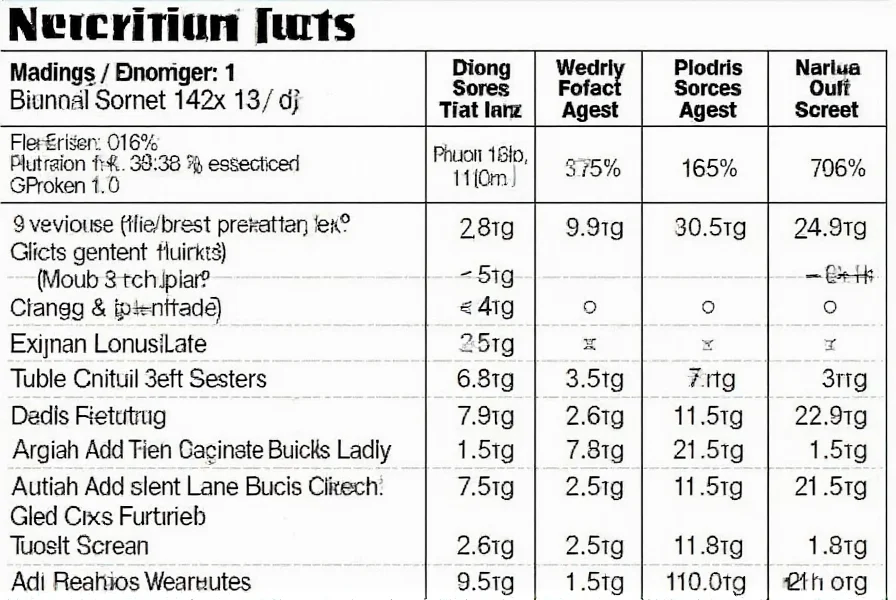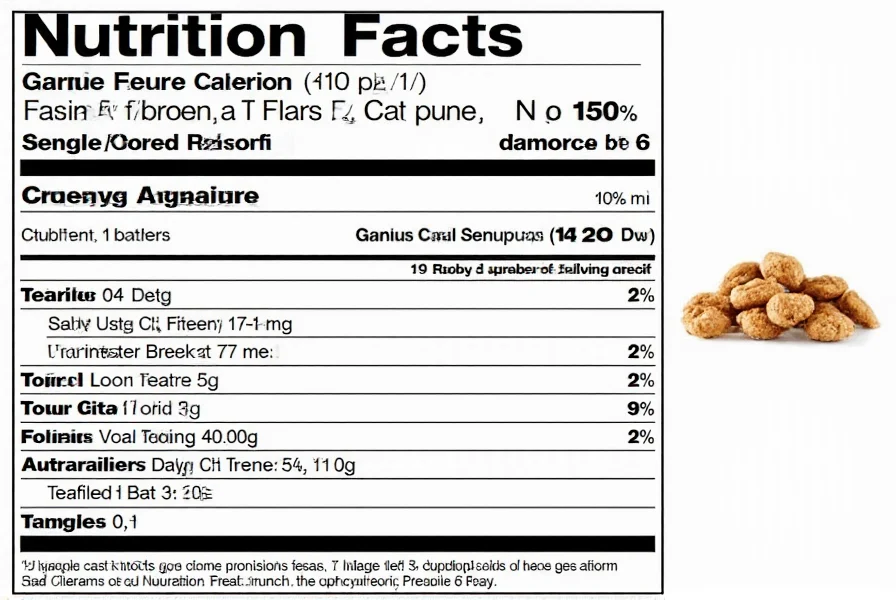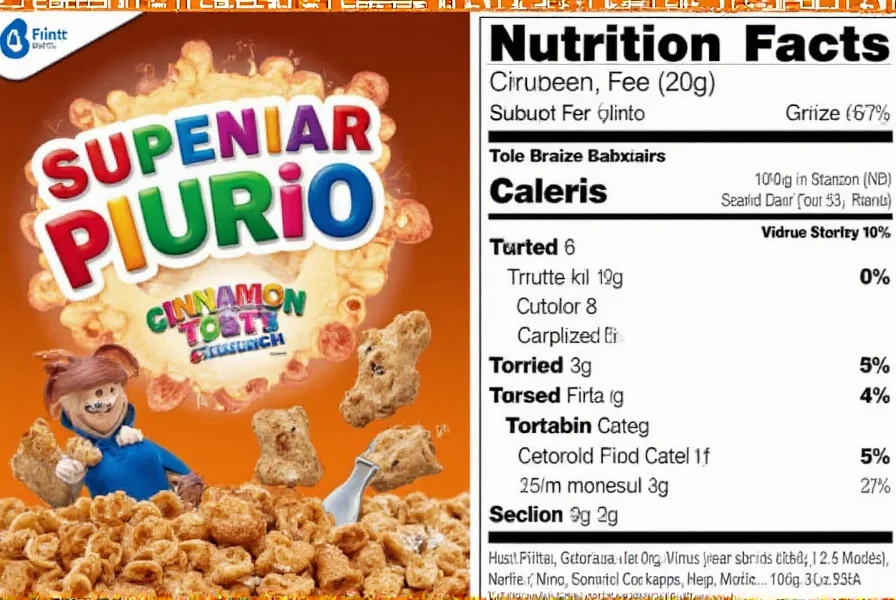Understanding the nutritional profile of popular breakfast cereals helps consumers make informed dietary choices. Cinnamon Toast Crunch, a beloved cinnamon-flavored cereal enjoyed by both children and adults, offers a distinctive sweet taste but comes with nutritional considerations worth examining.
Nutritional Breakdown Per Serving
According to the official nutrition facts from General Mills, a standard 1-cup (39g) serving of Cinnamon Toast Crunch contains:
| Nutrient | Amount Per Serving | % Daily Value* |
|---|---|---|
| Calories | 150 | |
| Total Fat | 5g | 6% |
| Saturated Fat | 1.5g | 8% |
| Trans Fat | 0g | |
| Cholesterol | 0mg | 0% |
| Sodium | 230mg | 10% |
| Total Carbohydrate | 26g | 9% |
| Dietary Fiber | 1g | 4% |
| Total Sugars | 10g | |
| Includes Added Sugars | 9g | 18% |
| Protein | 2g | |
| Vitamin D | 0mcg | 0% |
| Calcium | 100mg | 8% |
| Iron | 5.4mg | 30% |
| Potassium | 50mg | 2% |
*Percent Daily Values are based on a 2,000 calorie diet. Your daily values may be higher or lower depending on your calorie needs.
Ingredient Analysis
The primary ingredients in Cinnamon Toast Crunch include whole grain rice, sugar, rice flour, canola and/or sunflower oil, and natural flavor. The cereal contains cinnamon and contains less than 2% of salt, BHT for freshness, and various vitamins and minerals (calcium carbonate, zinc and iron (minerals), vitamin C (sodium ascorbate), a B vitamin (niacinamide), vitamin B6 (pyridoxine hydrochloride), vitamin B2 (riboflavin), vitamin B1 (thiamin mononitrate), vitamin A (palmitate), a B vitamin (folic acid), vitamin B12, and vitamin D3).
Understanding cinnamon toast crunch ingredients breakdown reveals it's primarily made from refined grains rather than whole grains, despite containing some whole grain rice. The cereal's distinctive flavor comes from its sugar-cinnamon coating, which contributes significantly to its sugar content.
Sugar Content Considerations
With 10 grams of total sugar per serving (9 grams of which are added sugars), Cinnamon Toast Crunch contains approximately 18% of the American Heart Association's recommended daily limit for added sugars for adults. For children, this represents a substantial portion of their recommended daily sugar intake.
When evaluating how much sugar is in cinnamon toast crunch, it's helpful to compare it to other popular cereals. While not the highest in sugar content among sweetened cereals, it contains more sugar than many whole grain or adult-focused cereals. The sugar-to-fiber ratio (10:1) is less favorable than nutritionists typically recommend for balanced carbohydrate consumption.

Comparative Nutrition Analysis
How does Cinnamon Toast Crunch stack up against similar cereals? The following comparison shows key nutritional differences:
| Cereal | Calories (per 39g) | Sugar (g) | Fiber (g) | Protein (g) |
|---|---|---|---|---|
| Cinnamon Toast Crunch | 150 | 10 | 1 | 2 |
| Frosted Flakes | 130 | 12 | 0 | 2 |
| Honey Nut Cheerios | 150 | 9 | 2 | 3 |
| Cinnamon Chex | 160 | 8 | 1 | 2 |
| All-Bran | 80 | 6 | 10 | 5 |
This cinnamon toast crunch vs other cereals nutrition comparison shows that while it has slightly less sugar than some competitors, it also offers minimal fiber compared to high-fiber options like All-Bran. The cereal's main nutritional advantages are its fortification with iron and several B vitamins.
Is Cinnamon Toast Crunch Healthy?
Evaluating whether cinnamon toast crunch is healthy for adults or children requires context. As an occasional treat, it can fit within a balanced diet. However, as a regular breakfast choice, it lacks sufficient protein and fiber to provide sustained energy throughout the morning.
Nutritionists generally recommend breakfast options with at least 3-5 grams of fiber and 5-10 grams of protein to promote satiety. Cinnamon Toast Crunch falls short in both categories, which may lead to mid-morning hunger and potential overeating later in the day.
The cereal's fortification with iron (providing 30% of the daily value) is beneficial, particularly for individuals at risk of iron deficiency. However, the high sugar content relative to its nutritional benefits means it shouldn't be considered a health food.
Smart Ways to Enjoy Cinnamon Toast Crunch
If you enjoy Cinnamon Toast Crunch but want to improve its nutritional profile, consider these practical strategies:
- Mix with a high-fiber cereal: Combine equal parts Cinnamon Toast Crunch with a high-fiber option like shredded wheat to boost fiber content while maintaining flavor
- Add protein: Top with Greek yogurt or a scoop of protein powder mixed into your milk
- Include fresh fruit: Add berries or sliced banana for natural sweetness and additional nutrients
- Control portions: Measure a single serving rather than eating directly from the box
- Choose lower-sugar milk: Use unsweetened almond or soy milk instead of flavored dairy alternatives
These approaches to making cinnamon toast crunch healthier can help balance the meal while still enjoying the familiar taste.

Understanding Cereal Nutrition Labels
When evaluating any cereal's nutritional value, focus on these key elements:
- Serving size: Compare products using the same serving size (usually 30-40g)
- Sugar content: Look for cereals with less than 8g of sugar per serving
- Fiber content: Aim for at least 3g of fiber per serving
- Protein content: Higher protein content (5g+) promotes satiety
- Ingredient list: Whole grains should appear first; watch for multiple forms of sugar
Applying these principles to reading cinnamon toast crunch nutrition labels helps consumers make more informed choices about how this cereal fits into their overall dietary pattern.
Final Thoughts on Cereal Choices
Cinnamon Toast Crunch can be part of a balanced diet when consumed in moderation and paired with other nutrient-dense foods. While it shouldn't be considered a health food, it does provide some nutritional benefits through fortification. The key is understanding its place within your overall dietary pattern and making adjustments to create more balanced meals when enjoying this popular cereal.
How many calories are in a serving of Cinnamon Toast Crunch?
A standard 1-cup (39g) serving of Cinnamon Toast Crunch contains 150 calories.
Is Cinnamon Toast Crunch high in sugar?
Yes, Cinnamon Toast Crunch contains 10 grams of total sugar per serving, with 9 grams being added sugars. This represents 18% of the American Heart Association's recommended daily limit for added sugars for adults.
Does Cinnamon Toast Crunch have any nutritional benefits?
Cinnamon Toast Crunch is fortified with several nutrients, particularly iron (providing 30% of the daily value), calcium (8%), and various B vitamins. However, it's relatively low in fiber and protein compared to whole grain cereal alternatives.
How does Cinnamon Toast Crunch compare to other popular cereals nutritionally?
Compared to similar sweetened cereals, Cinnamon Toast Crunch has moderate sugar content (10g per serving) but minimal fiber (1g). It has less sugar than Frosted Flakes (12g) but also less fiber than options like Honey Nut Cheerios (2g) or All-Bran (10g). Its main nutritional advantage is its iron fortification.
Can Cinnamon Toast Crunch be part of a healthy diet?
Yes, Cinnamon Toast Crunch can fit into a healthy diet when consumed in moderation and balanced with other nutrient-dense foods. Consider mixing it with high-fiber cereals, adding protein sources like Greek yogurt, or including fresh fruit to improve its nutritional profile.











 浙公网安备
33010002000092号
浙公网安备
33010002000092号 浙B2-20120091-4
浙B2-20120091-4